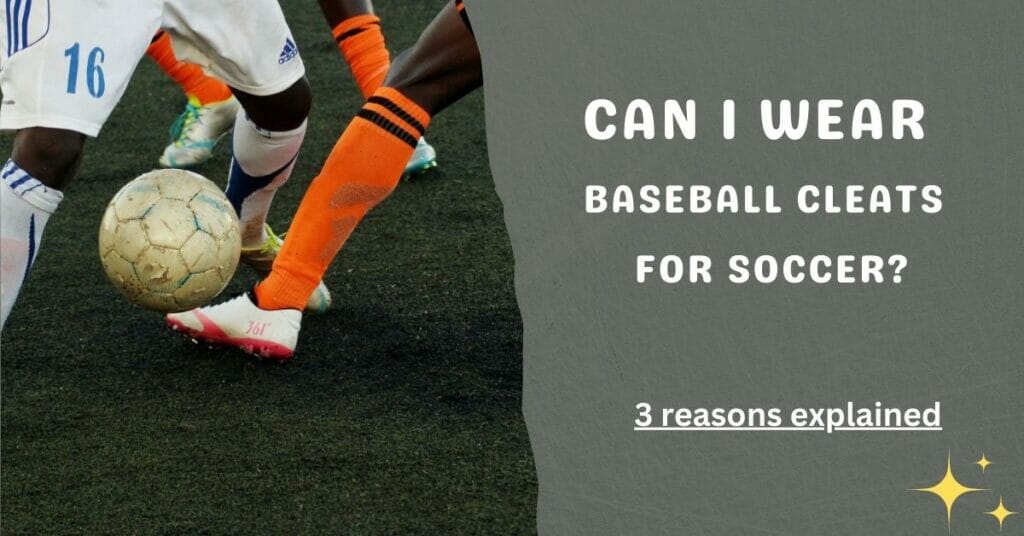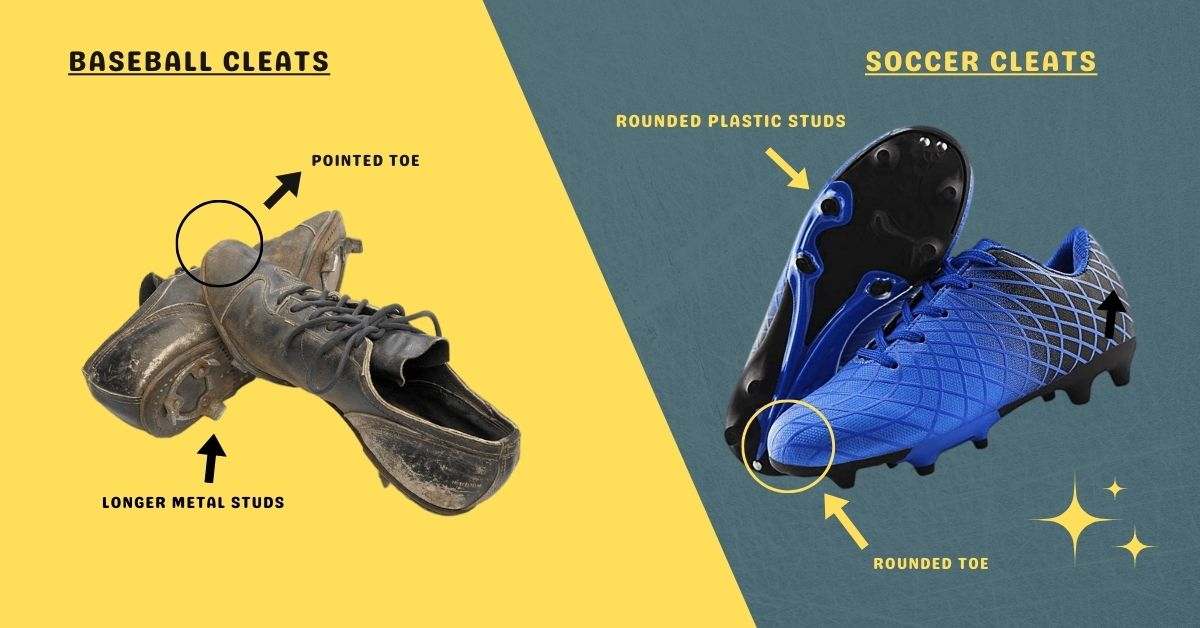
Regarding sports, having the right footwear is crucial for performance and safety. Soccer and baseball are two popular sports requiring specialized cleats.
In this article, we will explore about can you wear baseball cleats for soccer also the differences between Soccer and baseball cleats, address whether they can be used for Soccer, and provide insights into when it is appropriate to wear them.
So, let’s dive in and discover the nuances of cleats designed for these exciting sports.
Can You Wear Baseball Cleats For Soccer?
While it is technically possible to wear baseball cleats for Soccer, it is generally not recommended for several reasons.
1. The pointed-toe design of baseball cleats can restrict ball control in Soccer and may cause discomfort during kicking.
2. Additionally, the longer metal cleats commonly found in baseball are generally not permitted in Soccer due to safety concerns, especially on natural grass surfaces.
3. Metal cleats can risk players’ safety, potentially causing injuries during tackles or accidental contact.
What is the Difference between Baseball and Soccer Cleats?
The main differences between baseball and soccer cleats lie in their design and functionality.
Baseball cleats have a pointed toe and longer metal studs, providing traction on dirt or grass surfaces,
while soccer cleats have a rounded toe and shorter molded plastic studs, offering optimal grip and agility on natural grass or artificial turf specifically designed for soccer.
Let’s dive into the details to understand the disparities between these two types of cleats:
1. Toe and Stud Pattern

Soccer cleats are designed with a rounded toe. This shape allows for better ball control and a more natural kicking motion.
The rounded toe facilitates dribbling, passing, and shooting, providing a larger surface area to contact the ball.
Baseball cleats, on the other hand, often feature a more pointed toe. The pointed design lets baseball players dig into the dirt or grass surface, offering stability and traction during quick movements, such as sprinting or changing direction on the baseball field.
2. Studs or Cleat Pattern
Soccer cleats typically have a variety of stud patterns that are molded into the sole. These studs are strategically positioned to provide optimal traction and grip on different playing surfaces, including natural grass, artificial turf, or hard ground.
The stud patterns can vary, with some cleats featuring conical studs, bladed studs, or a combination. These patterns enhance traction and prevent slippage while allowing for quick turns, sudden stops, and agile movements.
Baseball cleats also feature studs or cleats, but the design specifically caters to the baseball field. The studs on baseball cleats are often longer and more aggressive than soccer cleats.
Baseball cleats can have metal studs, molded plastic studs, or a combination. The longer studs on baseball cleats offer stability during running and help players grip the surface while making quick lateral movements on the dirt or grass.
3. Materials Used
Soccer cleats are typically constructed from lightweight synthetic materials or genuine leather. These materials provide flexibility, durability, and breathability.
The lightweight design of soccer cleats enhances players’ speed and agility, allowing for swift movements and quick reactions on the field.
The materials used in soccer cleats are chosen to provide comfort and support during extended periods of play.
Baseball cleats often utilize heavier materials such as genuine, synthetic, or synthetic materials with additional reinforcements.
These materials offer durability and protection against the wear and tear of sliding, running, and playing on abrasive surfaces like baseball turf or dirt.
Baseball cleats must withstand the game’s demands and provide adequate foot and ankle support.
4. Safety Considerations

Soccer cleats prioritize safety by focusing on minimizing the risk of injuries. The stud patterns on soccer cleats are designed to provide optimal traction without causing harm to opponents.
They are typically made of molded plastic or rubber, which reduces the likelihood of causing cuts or injuries during tackles or accidental contact.
Baseball cleats, especially those with metal studs, can pose safety concerns when used in Soccer.
The sharp edges of metal cleats increase the risk of injury to other players during tackles or collisions.
For this reason, many soccer leagues prohibit using metal cleats to ensure the safety of all participants.
Soccer and baseball cleats are tailored to each sport’s specific needs and demands. The differences in toe and stud patterns, materials used, and safety considerations make them distinct.
Understanding these differences is essential for selecting the appropriate cleats for optimal performance, comfort, and safety on the field.
Might be You are interested in related Articles:
1. Can you play Soccer with Glasses?
2. Can You Wear Soccer Cleats for Softball
3. CAN You Use Soccer Cleats for American Football?
When to Wear Baseball Cleats for Soccer?
While it is generally not recommended to wear baseball cleats for Soccer due to the differences in design and safety concerns, there might be a few scenarios where wearing baseball cleats could be considered for Soccer:
Casual Recreational Games
In informal or casual soccer games played on non-professional or non-regulation fields, some players may opt to wear baseball cleats if they do not have access to soccer cleats.
Players might prioritize convenience over optimal performance since these games often lack intense competition and adhere to relaxed rules.
Hard Ground Surfaces
Baseball cleats may provide better traction than those designed for natural grass or turf if the soccer game is played on a hard ground surface, such as a concrete or asphalt field.
The sturdier construction and longer studs of baseball cleats can offer improved grip on hard surfaces, minimizing the risk of slipping.
Personal Preference
In some cases, individual player preference may influence the decision to wear baseball cleats for Soccer.
Players with a background in baseball and are more comfortable with the fit, feel, and performance of baseball cleats may choose to use them for Soccer, especially if they do not have immediate access to soccer-specific footwear.
However, it’s important to note that even in these scenarios, there are potential drawbacks and safety concerns when using baseball cleats for Soccer.
The pointed-toe design of baseball cleats can affect ball control and kicking accuracy in Soccer.
It is always recommended to wear soccer cleats specifically designed for the sport whenever possible.
Soccer cleats are purpose-built to provide optimal performance, agility, and safety on the soccer field, taking into account the unique demands and movements of the game.
When Not to Wear Baseball Cleats for Soccer?

It is generally advised not to wear baseball cleats for Soccer for several reasons. Here are some scenarios where wearing baseball cleats for Soccer is not recommended:
Official Matches and League
In organized soccer matches and league baseball, it is important to adhere to the governing bodies’ regulations and guidelines.
These regulations often specify the type of footwear allowed, and baseball cleats are typically not permitted.
Soccer cleats are designed to meet the specific requirements of the game, ensuring fair play and minimizing the risk of injuries.
Natural Grass or Turf Surfaces
Soccer is commonly played on natural grass or artificial turf surfaces. Baseball cleats, especially those with longer metal studs, can cause damage to the playing surface, such as tearing up the grass or damaging the turf. This not only affects the quality of the field but also poses a safety hazard to players.
Safety Concerns
Baseball cleats often feature metal studs, which are potentially dangerous when used in Soccer.
Metal cleats increase the risk of causing injuries to other players during tackles or accidental contact.
In Soccer, where there is a higher likelihood of proximity and contact between players, it is crucial to prioritize safety by wearing appropriate footwear.
Ball Control and Kicking Accuracy
The design of baseball cleats, with their pointed toe, can restrict ball control and affect kicking accuracy in Soccer.
Soccer cleats are specifically designed with a rounded toe to facilitate better ball handling, passing, and shooting techniques. Using baseball cleats may hinder a player’s ability to perform these skills effectively.
Comfort and Performance
Soccer cleats are engineered to provide the optimal balance of support, flexibility, and comfort required for dynamic movements in Soccer.
Baseball cleats, designed for specific movements and baseball requirements, may offer a different level of performance and agility on the soccer field.
Wearing baseball cleats for Soccer could hinder a player’s ability to perform at their best.
It is generally advised against wearing baseball cleats for Soccer in official matches, on natural grass or turf surfaces, and for safety reasons.
Soccer cleats are purpose-built to meet the specific demands of the game, offering better ball control, traction, and overall performance.
To ensure safety, adhere to regulations, and optimize your soccer experience, it is recommended to wear appropriate soccer cleats designed for the sport.
Next Read: CAN You Use Soccer Cleats for American Football?
Conclusion
it is important to prioritize soccer cleats over baseball cleats for the game of soccer. Soccer cleats are purpose-built with features like rounded toes, molded plastic cleats, and lightweight materials, ensuring better performance and reducing the risk of injuries.
Avoid using baseball cleats for soccer due to variations in toe and stud patterns, as well as safety concerns associated with metal cleats.
Invest in high-quality soccer cleats, such as Adidas soccer cleats, to enhance your gameplay and enjoy the sport to the fullest.
FAQs
Can my kid wear baseball cleats for Soccer?
While it is not recommended, it is generally safe for kids to wear baseball cleats for Soccer in casual or non-competitive settings. However, it is important to consider the potential drawbacks, such as reduced ball control and safety concerns associated with metal cleats. Providing your child with proper soccer cleats for optimal performance and safety is advisable.
Can football cleats be used for Soccer?
Football cleats are not recommended for Soccer. While there may be some similarities between the two sports, such as playing on grass surfaces, football cleats are designed differently. Football cleats often have larger studs or spikes, which can cause discomfort and affect agility and ball control in Soccer. It is best to use soccer-specific cleats to ensure the best performance and minimize the risk of injuries.
Can soccer cleats be used for baseball?
Soccer cleats should not be used for baseball. Baseball requires different types of cleats, particularly those designed for the demands of the sport, such as running on dirt or turf surfaces and making quick lateral movements. With their stud patterns and rounded toe design, soccer cleats may need to provide more traction and stability for baseball activities. It is recommended to use baseball-specific cleats for optimal performance and safety in baseball.
Can soccer cleats be used for other sports?
While soccer cleats are primarily designed for Soccer, they can be used for other sports played on similar surfaces, such as field hockey or lacrosse. However, it is important to check each sport’s specific regulations and requirements to ensure that the cleats are permitted and suitable for the activities involved. Sports may have different cleat regulations and design specifications, so it’s best to consult the respective sport’s guidelines.
What should I consider when choosing soccer cleats for my child?
When choosing soccer cleats for your child, it’s important to consider their age, foot size, playing style, and the playing surface they will primarily be on. Look for cleats that provide proper fit, support, and comfort. Consider the stud pattern suitable for the playing surface (e.g., molded plastic cleats for natural grass, turf soccer shoes for artificial turf). Additionally, prioritize durability and quality to ensure the cleats withstand the demands of the game and provide optimal performance.


